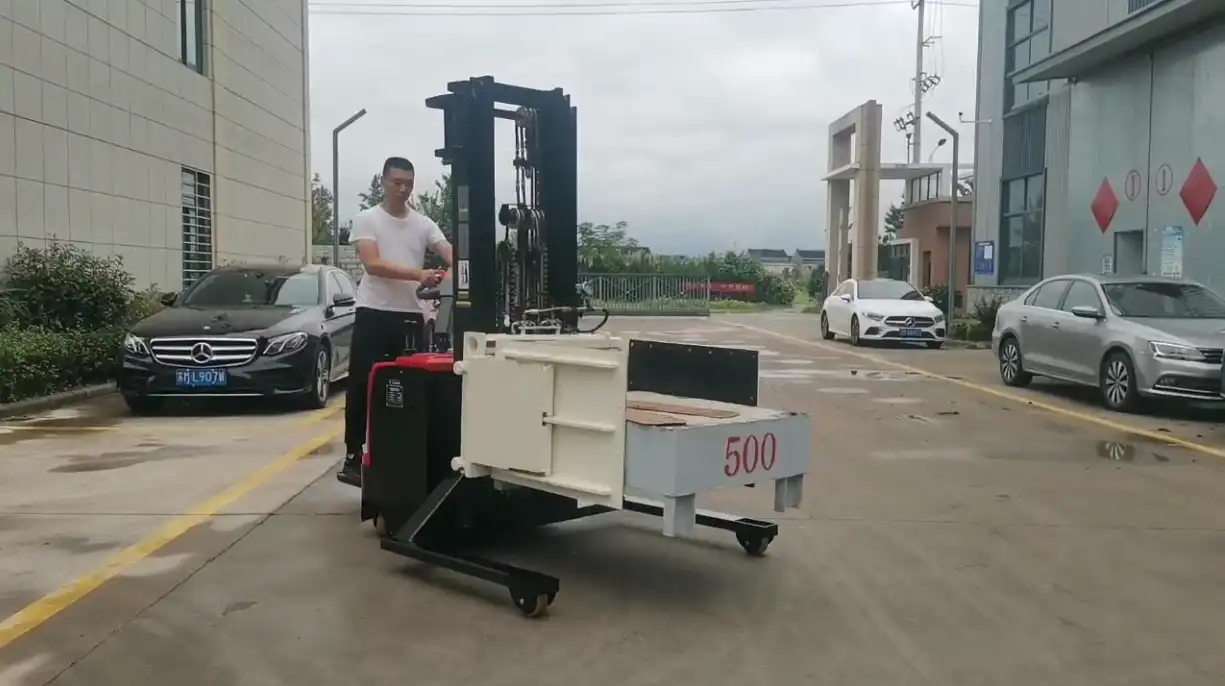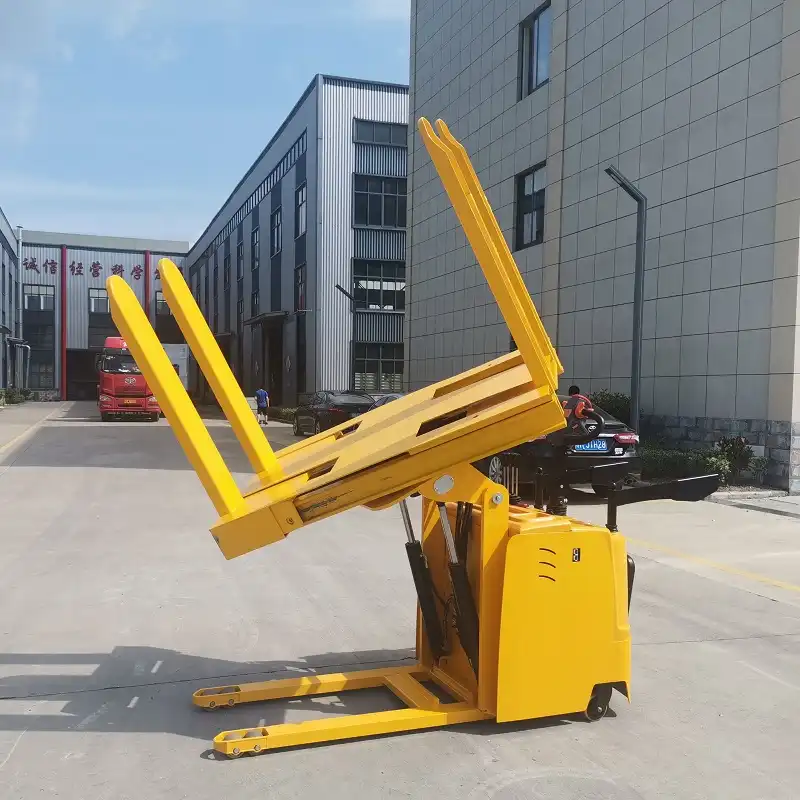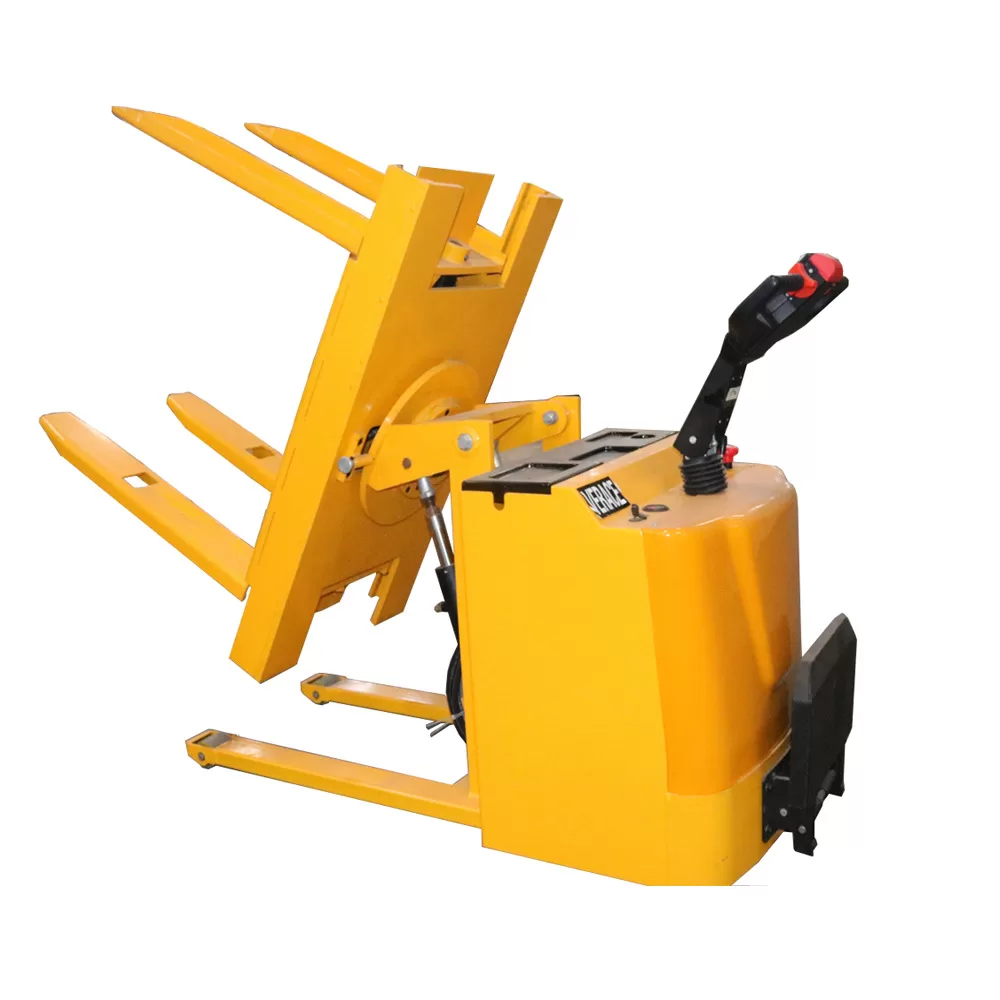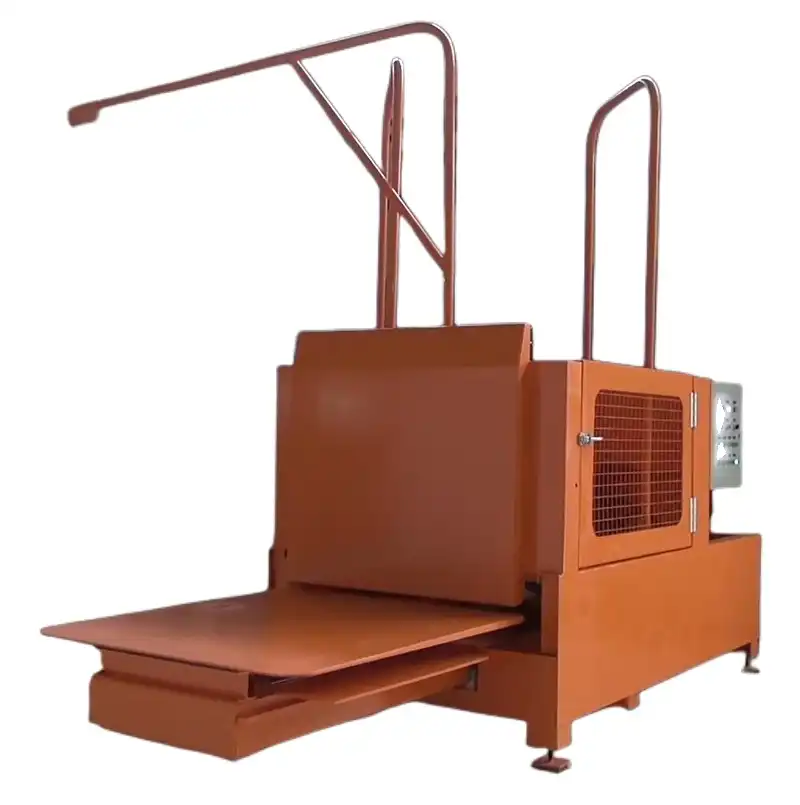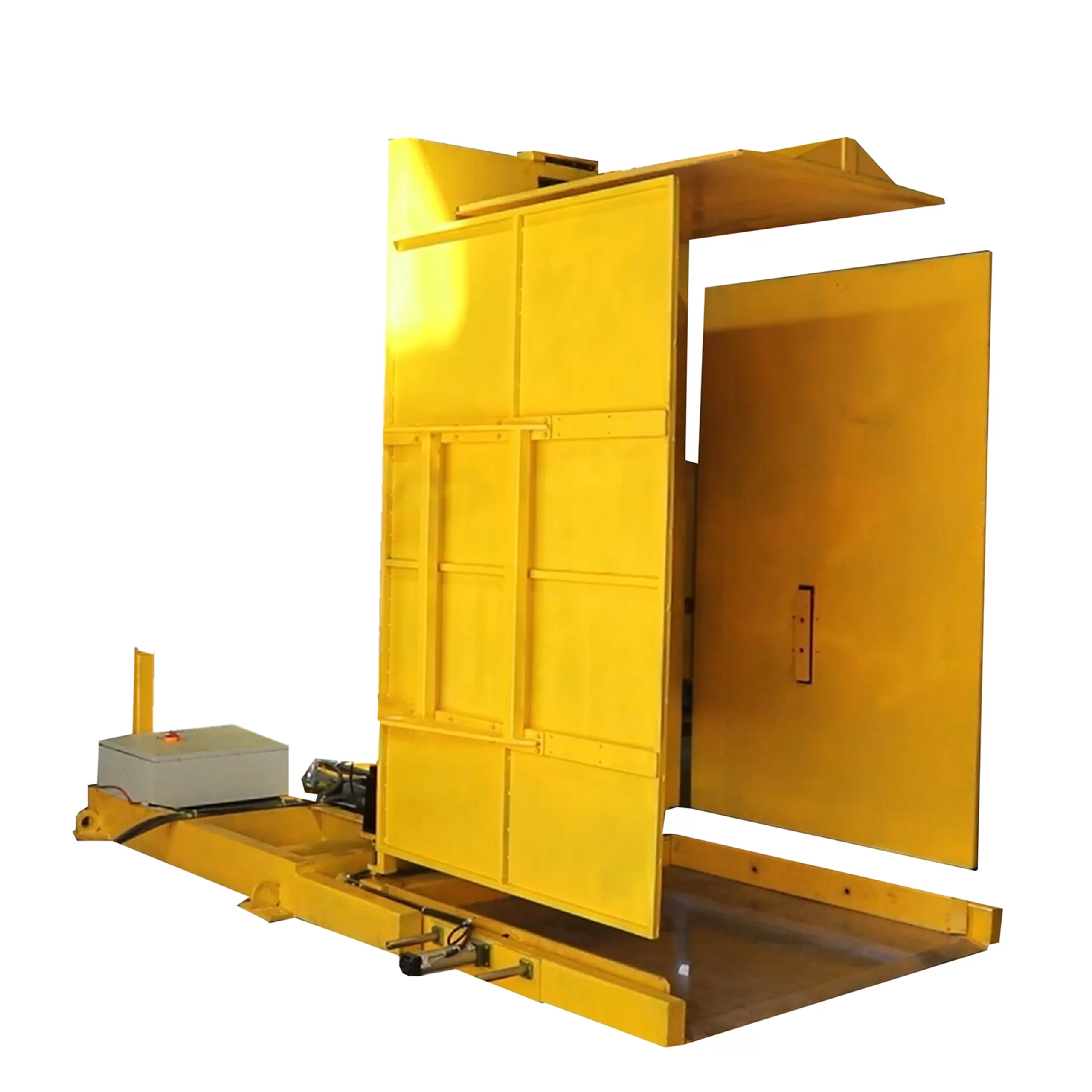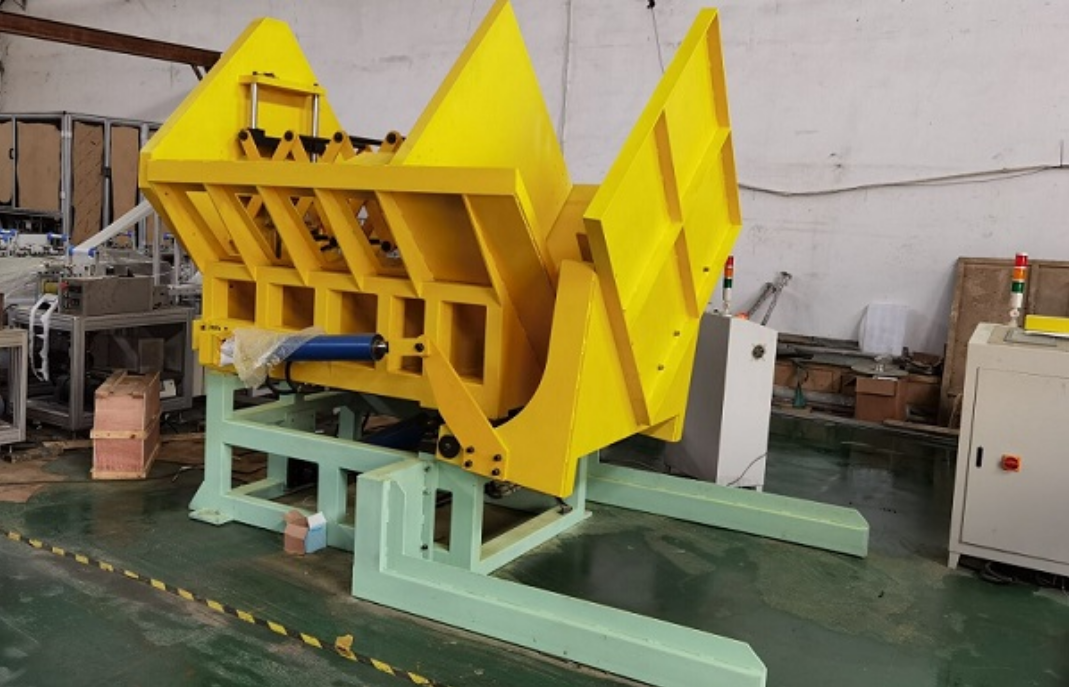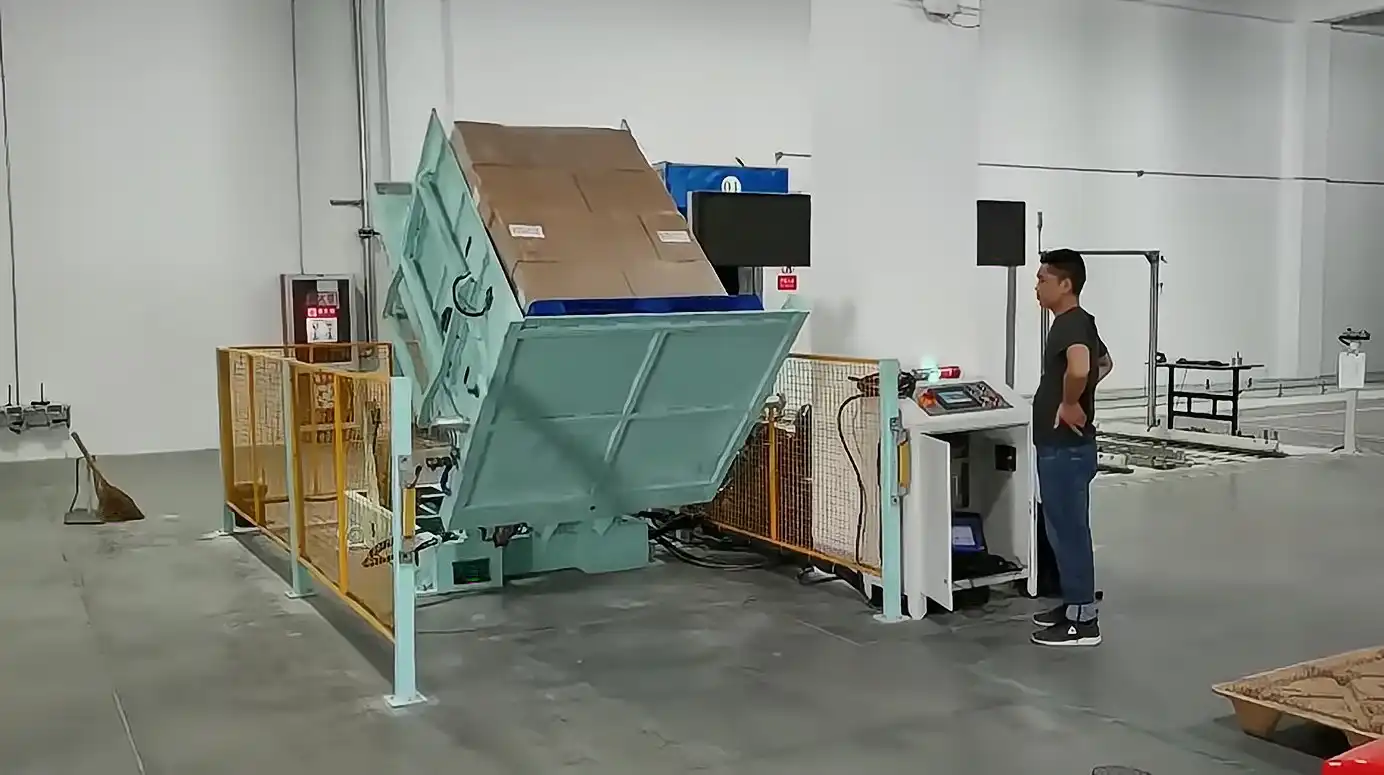Pallet Inverter for Material Handling: Technical Specification and Implementation Analysis
What is a Pallet Inverter and How Does It Work?
A pallet inverter (also called pallet changing machine) is an industrial material handling device that rotates loaded pallets 180 degrees to transfer products between pallets without manual restacking. FHOPEPACK designs pallet inverter systems with hydraulic clamping mechanisms that secure loads weighing 500-2500 kg, rotate the assembly at controlled speeds of 3-8 rpm, and complete the inversion cycle in 45-90 seconds. Unlike manual restacking (requiring 15-25 minutes per pallet) or forklift tilting operations (with 8-12% product damage rates), the pallet changing machine maintains load stability through adjustable pressure plates (0.3-0.8 MPa) and programmable rotation sequences.
Application Industries for Pallet Inverter Systems
Pallet inverter technology serves diverse sectors requiring efficient pallet exchange:
- Food & Beverage Industry: Product transfer for damaged pallet replacement, hygiene compliance (processing 80-120 pallets/shift)
- Pharmaceutical & Chemical Industry: Clean room pallet exchange, GMP-compliant material transfer (0.1% contamination tolerance)
- Warehouse & Distribution Centers: Pallet standardization operations (converting 1200×1000mm to 1200×800mm formats)
- Cold Chain & Frozen Food Storage: Rapid pallet changeover minimizing cold exposure (cycle time <90 seconds at -25°C)
- Packaging & Manufacturing: Production line pallet rotation, damaged base replacement (throughput 100-150 pallets/day)
- Electronics & Components Industry: Static-free pallet transfer for sensitive products (ESD protection rated <100V)

What Challenges Do Warehouse and Manufacturing Facilities Face?
Material handling operations encounter three critical pallet exchange challenges: manual restacking operations consume 15-25 minutes per pallet with 3-4 laborers, resulting in annual labor costs exceeding $85,000 for facilities processing 50 pallets daily. Forklift tilting operations demonstrate 8-12% product damage rates due to unstable load angles (typically 25-35 degrees), causing $45,000-65,000 annual losses in damaged goods for mid-sized warehouses processing 12,000 pallets yearly.
Operational Constraints in Traditional Methods
Conventional pallet exchange methods report:
- Manual restacking time: 15-25 minutes per pallet (labor-intensive for 1000-1500 kg loads)
- Forklift operation risks: 8-12% damage rate, safety incidents averaging 2.5 per 1000 operations
- Labor requirements: 3-4 personnel per restacking operation
- Throughput limitation: 20-30 pallets per 8-hour shift (manual methods)
- Ergonomic issues: Repetitive lifting causes 15-20% workforce injury rates annually
Product Integrity Requirements in Regulated Industries
Pharmaceutical and food sectors face stringent pallet handling standards: FDA requires <0.5% product contamination during pallet transfer, while cold chain operations demand cycle times under 90 seconds to maintain temperature integrity (-18 to -25°C environments). Traditional forklift tilting fails these requirements 12-18% of the time due to uncontrolled rotation speeds and inadequate load securing mechanisms.

How is a Pallet Inverter System Designed?
FHOPEPACK pallet changing machine systems integrate four functional modules for automated load inversion:
- Hydraulic clamping system: Adjustable pressure plates 0.3-0.8 MPa, accommodating load heights 800-2200mm
- Rotation mechanism: 180-degree inversion via hydraulic cylinders, speed control 3-8 rpm, positioning accuracy ±2 degrees
- Safety interlock system: Dual pressure sensors, emergency stop response time <0.5 seconds, overload detection at 110% rated capacity
- Control interface: PLC-based operation with 20+ programmable recipes, HMI touchscreen (7-inch display), cycle counter and maintenance alerts
Technical Specifications
| Parameter | Standard Model | Heavy-Duty Model |
|---|---|---|
| Load capacity | 1000-1500 kg | 1800-2500 kg |
| Pallet dimensions | 800×1200 to 1200×1200 mm | 1000×1200 to 1500×1500 mm |
| Load height range | 800-1800 mm | 1000-2200 mm |
| Rotation speed | 3-6 rpm | 4-8 rpm |
| Cycle time | 45-75 seconds | 60-90 seconds |
| Clamping force | 0.4-0.6 MPa | 0.6-0.8 MPa |
| Power consumption | 5.5 kW | 7.5 kW |
| Hydraulic system | 10 L capacity, 15 MPa max | 18 L capacity, 20 MPa max |
| Control system | Siemens PLC S7-1200 | Siemens PLC S7-1500 |
How Does Pallet Inverter Performance Compare to Manual Methods?
| Metric | Manual Restacking | Forklift Tilting | Pallet Inverter | Improvement vs Manual |
|---|---|---|---|---|
| Cycle time per pallet | 15-25 min | 8-12 min | 1-1.5 min | -93-96% |
| Labor requirement | 3-4 workers | 1 operator + assistant | 1 operator | -67-75% |
| Product damage rate | 2-5% | 8-12% | 0.2-0.8% | -84-96% |
| Throughput (8h shift) | 20-30 pallets | 40-60 pallets | 240-320 pallets | +700-1500% |
| Safety incidents/1000 ops | 8-12 | 15-20 | 0.5-1.5 | -87-94% |
| Energy cost per cycle | N/A | $0.85-1.20 (diesel) | $0.15-0.25 (electric) | Measurable baseline |
What is the ROI of Implementing a Pallet Inverter?
Capital Investment Structure
Base equipment cost (FHOPEPACK): $12,000-15,000 FOB (configuration-dependent)
Shipping to destination: $2,200-3,500 (route-dependent)
Installation and commissioning: $2,800
Operator training (16 hours): $800
Total project cost: $17,800-22,100
Annual Operating Cost Reduction
Based on 250 working days, single-shift operation processing 80 pallets/day (20,000 pallets/year):
- Labor savings: 2.5 workers × $28,000/year = $70,000
- Damage reduction: 8% defect rate × 20,000 pallets × $35 average loss = $56,000
- Productivity gains: 60 additional pallets/day × $8 margin × 250 days = $120,000
- Safety cost avoidance: 15 incidents/year × $4,500 average cost = $67,500
Total annual benefit: $313,500
Simple payback period: 0.7-0.9 months (21-27 days)
3-year NPV (8% discount rate): $786,000-790,000

How Long Does Pallet Inverter Installation Take?
| Phase | Duration | Technical Requirements |
|---|---|---|
| Pre-installation site assessment | 2-3 days | Floor loading 800 kg/m², clearance 3.5m height |
| Equipment fabrication | 15-25 days | Custom dimensions if non-standard pallets |
| International shipping | 25-45 days | Route-dependent (Asia-Europe 28-35d, Asia-Americas 30-45d) |
| Customs clearance | 2-4 days | HS code 8428.90 |
| On-site installation | 2-3 days | Forklift access (1.5-ton capacity minimum) |
| Hydraulic system setup | 1 day | Hydraulic oil ISO VG 46, 10-18 liters |
| Electrical integration | 1 day | 380-480V 3-phase, 15-25A breaker |
| System commissioning | 1 day | 20-pallet trial run, safety verification |
| Operator training | 1 day | Operation, safety protocols, basic maintenance |
Total implementation: 49-86 days from PO to production

What Maintenance Does a Pallet Inverter Require?
FHOPEPACK pallet changing machine systems require scheduled maintenance to maintain 99%+ uptime:
- Preventive maintenance interval: Every 2,500 operating hours (approximately 4-6 months at 80 cycles/day)
- Critical wear components: Hydraulic seals (replace every 15,000 cycles), pressure plates rubber padding (inspect monthly, replace every 8,000 cycles)
- Hydraulic system service: Oil change every 2,000 hours, filter replacement every 1,000 hours, hose inspection quarterly
- Spare parts recommended stock value: $3,200-4,800 (12-month coverage for 20,000 operating hours/year)
- Service response time: 24-72 hours via regional service network across 35+ countries
Frequently Asked Questions About Pallet Inverter Systems
Q: Can a pallet inverter handle unstable loads like bags or loose cartons?
A: Yes. FHOPEPACK pallet inverter systems feature adjustable clamping pressure (0.3-0.8 MPa) and side stabilization plates that accommodate loads with stability ratios down to 0.6 (height-to-width ratio). Optional top pressure plates ($2,800-4,200) provide additional securing for loads exceeding 1800mm height. Rotation speed is programmable (3-8 rpm) to minimize load shifting during inversion.
Q: How does a pallet changing machine integrate with automated warehouse systems?
A: FHOPEPACK designs include industrial protocol support: Profibus, EtherNet/IP, Modbus TCP for WMS/WCS integration. Digital I/O provides handshake signals (load ready, cycle start, inversion complete, fault alarm) with conveyor systems and AGVs. Integration typically requires 6-10 hours PLC configuration. Optional barcode scanner integration ($1,500) enables automatic load tracking.
Q: What pallet types are compatible with pallet inverter equipment?
A: Pallet inverter systems accommodate wooden pallets (EUR, EPAL, GMA standards), plastic pallets (HDPE/PP construction), metal pallets (steel/aluminum), and specialized pallets (cold chain, pharmaceutical). Dimension range: 800×1000mm to 1500×1500mm. Custom clamping plates available for non-standard sizes (additional $1,200-2,500). Maximum pallet + load height: 2200mm for heavy-duty models.
Q: What are power and space requirements for installation?
A: Standard FHOPEPACK pallet changing machine requires 380-480V 3-phase power, 50/60Hz (auto-sensing), 15-25A circuit protection. Power consumption: 5.5kW (standard) to 7.5kW (heavy-duty). Footprint: 2.5m (W) × 3.2m (L) × 3.5m (H) including safety zone per ISO 13857. Floor loading requirement: 800 kg/m² for concrete foundation. Noise level: 72-78 dB(A) at 1 meter distance.
Q: Can the system operate in cold storage or clean room environments?
A: Yes. FHOPEPACK offers cold-rated models (-30°C to +5°C operating range) with low-temperature hydraulic oil (ISO VG 22) and stainless steel construction. Clean room versions (ISO Class 5-7) feature sealed components, washdown-rated IP65 protection, and FDA-compliant materials. Cold storage models include heated hydraulic reservoirs and insulated components. Price premium: 15-25% over standard models.
Q: What safety features prevent load damage during rotation?
A: Multi-layer safety system includes: dual pressure sensors (redundant monitoring), overload detection at 110% rated capacity (automatic cycle abort), emergency stop buttons (4 positions, <0.5 second response), soft-start rotation acceleration (3-second ramp), positioning sensors (±2 degree accuracy), and automatic clamping verification before rotation initiation. Complies with CE Machinery Directive 2006/42/EC and OSHA 1910.212 standards.
What Technical Support is Available for Pallet Inverter Systems?
FHOPEPACK global service network provides comprehensive support infrastructure:
- Remote diagnostics: 24/7 VPN access with PLC remote monitoring, troubleshooting response within 4-8 hours, predictive maintenance alerts
- Preventive maintenance programs: Quarterly on-site inspection available through authorized distributors in 35+ countries (North America, Europe, Asia-Pacific, Middle East, Latin America)
- Spare parts distribution: Regional warehouses with 48-96 hour delivery to major industrial zones, 95% parts availability rate
- Technical documentation: Multilingual operation manuals, hydraulic schematics, electrical diagrams, PLC program documentation (English, Spanish, German, Chinese, Japanese, Portuguese, French)
- Training programs: On-site operator training (1 day, up to 6 operators), maintenance technician certification (2 days), remote webinar sessions, video library access for 24-month post-purchase
How to Select the Right Pallet Inverter Configuration
To receive detailed engineering package and quotation from FHOPEPACK:
- Provide load specifications (pallet dimensions, maximum weight, typical load height)
- Daily throughput requirement (pallets/shift, annual volume projection)
- Operating environment (temperature range, humidity, clean room classification if applicable)
- Pallet types in use (wooden/plastic/metal, dimensions, condition assessment)
- Integration requirements (existing conveyor systems, WMS connectivity, AGV compatibility)
- Regulatory compliance needs (FDA, GMP, CE marking, specific industry certifications)
Contact: FHOPEPACK engineering team provides preliminary system configuration and budgetary pricing within 48 hours. CAD layout drawings, load simulation analysis, and facility integration planning available upon request.

Summary: Key Advantages of Pallet Inverter Technology
A pallet inverter from FHOPEPACK delivers measurable operational improvements over manual restacking and forklift tilting methods:
Performance gains: 700-1500% throughput increase (from 20-30 to 240-320 pallets per 8-hour shift), 93-96% cycle time reduction (from 15-25 minutes to 1-1.5 minutes per pallet), 84-96% damage rate reduction (from 2-12% to 0.2-0.8%)
Cost efficiency: ROI payback period of 0.7-0.9 months (21-27 days), $313,500 annual benefit through labor savings ($70,000), damage reduction ($56,000), productivity gains ($120,000), and safety cost avoidance ($67,500). Total investment $17,800-22,100 including equipment, shipping, installation, and training
Technical capability: Handles loads 500-2500 kg, pallet dimensions 800×1000mm to 1500×1500mm, load heights to 2200mm, with programmable rotation speeds 3-8 rpm and positioning accuracy ±2 degrees
Operational reliability: 99%+ uptime with preventive maintenance every 2,500 hours, 24-72 hour spare parts delivery via FHOPEPACK global network
Implementation timeline: 49-86 days from purchase order to production, including international shipping (25-45 days), installation (2-3 days), and training (1 day)
Safety compliance: Meets CE Machinery Directive 2006/42/EC, OSHA 1910.212 standards, FDA material compliance for food/pharma applications, dual-sensor redundancy, emergency stop response <0.5 seconds
FHOPEPACK pallet changing machine systems with 35-country service network ensure long-term performance through remote diagnostics, multilingual documentation, regional spare parts distribution, and comprehensive operator training programs for food & beverage, pharmaceutical, cold chain, and warehouse applications globally.
Technical Data Package Download: Complete specification set includes hydraulic system schematics, electrical load calculations, floor loading requirements, safety compliance documentation (CE/OSHA/FDA), and ROI calculation templates for FHOPEPACK pallet inverter and pallet changing machine systems configured for global material handling applications.

